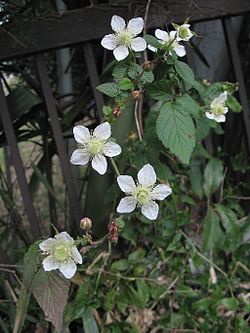Modern classification
Rubus is the only genus in the tribe Rubeae. [15]
Rubus is very complex, particularly within the blackberry/dewberry subgenus (Rubus), with polyploidy, hybridization, and facultative apomixis apparently all frequently occurring, making species classification of the great variation in the subgenus one of the grand challenges of systematic botany. In publications between 1910 and 1914, German botanist Wilhelm Olbers Focke attempted to organize the genus into 12 subgenera, a classification system that since became widely accepted, though modern genetic studies have found that many of these subgenera are not monophyletic. [7]
Some treatments have recognized dozens of species each for what other, comparably qualified botanists have considered single, more variable species. On the other hand, species in the other Rubus subgenera (such as the raspberries) are generally distinct, or else involved in more routine one-or-a-few taxonomic debates, such as whether the European and American red raspberries are better treated as one species or two (in this case, the two-species view is followed here, with R. idaeus and R. strigosus both recognized; if these species are combined, then the older name R. idaeus has priority for the broader species).
The classification presented below recognizes 13 subgenera within Rubus, with the largest subgenus (Rubus) in turn divided into 12 sections. Representative examples are presented, but many more species are not mentioned here. A comprehensive 2019 study found subgenera Orobatus and Anoplobatus to be monophyletic, while all other subgenera to be paraphyletic or polyphyletic. [16]
Phylogeny
The genus has a likely North American origin, [16] with fossils known from the Eocene-aged Florissant Formation of Colorado, around 34 million years old. [17] Rubus expanded into Eurasia, South America, and Oceania during the Miocene. [16] Fossil seeds from the early Miocene of Rubus have been found in the Czech part of the Zittau Basin. [18] Many fossil fruits of †Rubus laticostatus, †Rubus microspermus and †Rubus semirotundatus have been extracted from bore hole samples of the Middle Miocene fresh water deposits in Nowy Sacz Basin, West Carpathians, Poland. [19]
Molecular data have backed up classifications based on geography and chromosome number, but following morphological data, such as the structure of the leaves and stems, do not appear to produce a phylogenetic classification. [20]
Etymology
The generic name means blackberry in Latin and was derived from the word ruber, meaning "red". [24]
The blackberries, as well as various other Rubus species with mounding or rambling growth habits, are often called brambles. [25] However, this name is not used for those like the raspberry that grow as upright canes, or for trailing or prostrate species, such as most dewberries, or various low-growing boreal, arctic, or alpine species. The scientific study of brambles is known as "batology". "Bramble" comes from Old English bræmbel, a variant of bræmel. [5]


















